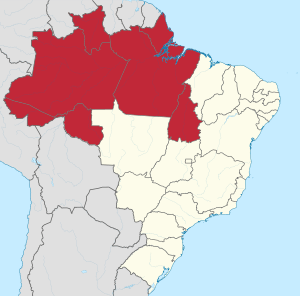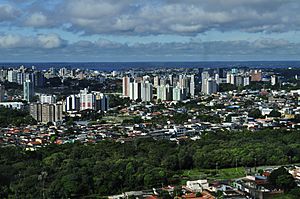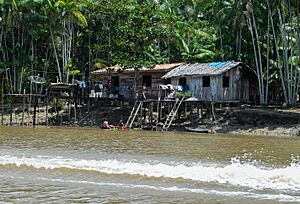North Region of Brazil facts for kids
Quick facts for kids
North Region
Região Norte
|
|
|---|---|

Location of North Region in Brazil
|
|
| Country | |
| Largest cities | Manaus Belém |
| States | Acre, Amapá, Amazonas, Pará, Rondônia, Roraima and Tocantins |
| Area | |
| • Region | 3,853,676.9 km2 (1,487,913.0 sq mi) |
| Area rank | 1st |
| Population
(2016 census)
|
|
| • Region | 17,707,783 |
| • Rank | 4th |
| • Density | 4.59503572/km2 (11.9010879/sq mi) |
| • Density rank | 5th |
| • Urban | 75.6% |
| GDP | |
| • Year | 2014 |
| • Total | R$308 billion (5th) |
| • Per capita | R$17,879 (4th) |
| HDI | |
| • Year | 2014 |
| • Category | 0.718 – high (4th) |
| • Life expectancy | 71 years (4th) |
| • Infant mortality | 25.8 per 1,000 (2nd) |
| • Literacy | 88.7% (4th) |
| Time zone | UTC-04 (BRT) |
| • Summer (DST) | UTC-03 (BRST) |
The North Region of Brazil is one of the five main areas that make up this huge country. It is located in the northern part of Brazil. This region is home to seven states: Acre, Amapá, Amazonas, Pará, Rondônia, Roraima, and Tocantins. It was one of the last parts of Brazil to get a lot of attention from the Brazilian government, even after Brazil became independent from Portugal.
This region is the largest in Brazil, covering about 45% of the country's land. That's almost half of Brazil! Even though it's so big, it has the fewest people living there compared to other regions. There are only about 2.92 people per square kilometer. This is because a huge part of the region is covered by the Amazon Rainforest.
Contents
Geography and Nature
The North Region is famous for its amazing natural environment. It is mostly covered by the Amazon Rainforest, which is the largest rainforest in the world. This forest is incredibly important for the planet.
The Amazon Rainforest
The Amazon Rainforest is like a giant green blanket. It is home to millions of different kinds of plants and animals. Many of these species are found nowhere else on Earth. The rainforest helps to produce a lot of the oxygen we breathe. It also plays a big role in controlling the world's climate.
The Amazon River
The mighty Amazon River flows through the North Region. It is the largest river in the world by the amount of water it carries. It is also one of the longest rivers. Thousands of smaller rivers and streams feed into the Amazon. This creates a huge network of waterways. These rivers are like highways for people and animals in the region. They are used for travel, fishing, and transporting goods.
Climate and Weather
The North Region has a hot and humid climate all year round. There is a lot of rain, especially during the wet season. This warm and wet weather helps the rainforest to grow so lush and green. The high humidity means the air often feels very moist.
Amazing Wildlife
The Amazon is a paradise for wildlife. You can find jaguars, monkeys, sloths, and many colorful birds. There are also unique animals like the pink river dolphin. The rivers are full of fish, including the giant pirarucu. Scientists are still discovering new species in this incredible place.
People and Culture
The North Region has a rich mix of cultures. Many different groups of people live here.
Indigenous Communities
Many indigenous communities live in the North Region. They have lived in the Amazon for thousands of years. They have a deep connection to the land and its resources. Their traditions, languages, and knowledge are very important. They often live in harmony with nature.
Traditional Ways of Life
Besides indigenous groups, many other people live along the rivers. They are often called ribeirinhos. These communities rely on the river for their daily lives. They fish, grow small crops, and use boats for transport. Their homes are often built on stilts to protect against floods.
Cultural Mix
Over time, people from other parts of Brazil and the world have also moved to the North Region. This has created a unique blend of cultures. You can see this mix in the food, music, and festivals of the region.
Major Cities
Even with vast rainforests, the North Region has some large and important cities.
The most important cities of the North Region are:
| City | Population (2007) |
|---|---|
| Manaus | 1,612,475 |
| Belém | 1,408,847 |
| Ananindeua | 484,600 |
| Porto Velho | 380,988 |
| Macapá | 368,397 |
| Rio Branco | 288,614 |
| Santarém | 274,074 |
Manaus
Manaus is the largest city in the North Region. It is located right in the middle of the Amazon Rainforest. It is a major port city, even though it's far from the ocean. Ships can travel up the Amazon River to reach Manaus. The city has a famous opera house called the Amazon Theatre. It was built during the rubber boom in the late 1800s.

Belém
Belém is another very important city. It is located closer to the Atlantic Ocean, at the mouth of the Amazon River. Belém is a historic city with beautiful old buildings. It is a major center for trade and culture in the region. The city is known for its delicious food and vibrant markets.
Economy and Development
The economy of the North Region is growing. It relies on its natural resources and some industries.
Natural Resources
The region has many natural resources. These include timber, minerals like iron ore and gold, and oil. Fishing is also a big part of the economy. Efforts are being made to use these resources in a sustainable way. This means using them without harming the environment too much.
Industry and Trade
Manaus has a special economic zone. This area attracts factories that make electronics and other goods. This helps to create jobs for people in the region. The rivers are very important for transporting goods and people.
Tourism
Tourism is also becoming more important. Many people visit the North Region to experience the Amazon Rainforest. They come to see the wildlife, explore the rivers, and learn about the local cultures. Ecotourism, which focuses on nature and conservation, is popular here.
Challenges and Conservation
The North Region faces some big challenges. Protecting the Amazon Rainforest is one of the most important.
Protecting the Amazon
The Amazon Rainforest is vital for the world. However, it faces threats from deforestation, illegal mining, and other activities. Many people and organizations are working to protect this amazing natural treasure. They want to make sure it stays healthy for future generations.

Images for kids





